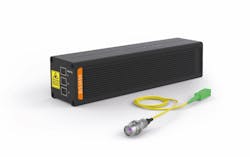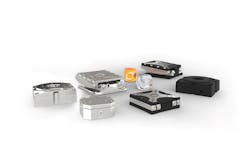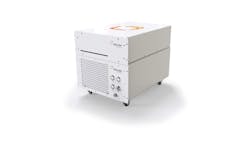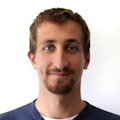Insights on nanotechnology solutions in research and industries
Since joining attocube systems AG in 2017, CEO Peter Kraemer has piloted the company through significant growth, building its NanoFactory in Haar, near Munich, in 2018, where all its products are manufactured, and in 2023, adding 1200 m2 of additional space for logistics, production, and testing.
During this time, he's overseen the company's expansion into industries such as semiconductor and quantum technologies, growing its team of physicists, engineers, software developers, and product designers from about 100 to 250 people.
In this interview, Kraemer shares insights into attocube's current and future direction and his view on what it will take to achieve the promise of quantum computing.
Ivan Nikitski: What are your company’s best-selling products and business growth areas?
Peter Kraemer: Our interferometer is really gaining speed. Some years ago, we built an industrial version of it, and at that time, not many people thought there was a need for such high precision. Now, everybody seems to want it, and we’re swamped with orders. There’s also high demand for our nanopositioners from academics involved in condensed metaphysics and from customers in the semicon and optics industry. The semiconductor equipment industry doesn’t need low temperatures, but they do need vacuum and stable systems ready for a clean room environment. The other growth area is quantum technology.
Nikitski: How important are quantum technologies for you right now?
Kraemer: We supply enabling technology for companies involved in quantum states and processes, such as single photon sources, trapped ions, and superconducting or photonic qubits. To maintain their quantum nature, these delicate states require cryogenic environments, low vibrations, or high vacuum. Fortunately, we can provide a range of low-vibration and unique compact rack cryostats, as well as high-precision components to align, operate, and test such advanced quantum systems. For example, our latest product—an ultra-compact, 19-inch rack-compatible closed-cycle mobile cryostat—can be used to cool the sensors. The device runs on 110–240 volts, doesn't need any water supply or special infrastructure, and can be used to cool quantum communication sensors and repeaters.
Nikitski: What's your projection for the quantum market?
Kraemer: There’s a lot of hype around quantum. Many competing concepts are in evaluation, and big money is being spent on R&D and industrialization. Whatever else happens, the future of the quantum computer is not a huge cryostat-based system. To make them feasible and useful, quantum computers will need to run in an office building or even be mobile.
Secondly, photons will be an integral part of quantum communication because photons are the only quantum information that can be dynamically sent over fibers. Accordingly, work on quantum communication, quantum repeaters, quantum sensing, and quantum sources will continue to increase, as will the demand for our cryostats.
If quantum is going to happen, there needs to be a transition from quantum research to quantum technology, and quantum will follow the same path as semicon in that it must get smaller, cheaper, and more scalable. A lot is happening now at the startup level—some companies are failing while others join the game. Successful development will depend on scalability.
Nikitski: What are the main challenges facing attocube these days?
Kraemer: There are still supply issues resulting from COVID. Things have improved, but there are still delivery time and quality issues. The other challenge is politics: We are working in a high-tech environment that is increasingly governed by import and export regulations and limited by embargos and restrictions.
Nikitski: What are your future challenges?
Kraemer: One of our aims is to further increase the share of industrial customers, who now account for around 20% of the business. Achieving this requires new strategic approaches and the reorganization of some processes in the company.
For example, for quantum startups to scale up, they will need to adopt an industrial approach in terms of delivery times, price, and performance. And to enable them to do this, we will need to work proactively to offer always better, scalable, and less costly products and services. For this reason, we developed our mobile cryostat solution.
In a nutshell, our aim is continuous product and process optimization. We realize this by transferring our academic knowledge and expertise into developing scalable industrial products while simultaneously adapting our processes and efficiency to meet the highest industry standards. If we manage this, I think we will be successful.
Nikitski: Tell me more about yourself and your appointment as CEO at attocube.
Kraemer: I have always been fascinated with physics at school, but also interested in working with people. After an education as an optometrist, I went to Aalen University in Germany to study for a Diploma Degree in Engineering in Optoelectronics. After graduating, I worked as a product manager for Carl Zeiss Microscopy in Göttingen, where I assumed responsibility for different applications and products in the research and clinical market.
Five years later, wanting to broaden my horizons, I moved to Mexico to work as Sales Director of Carl Zeiss’s Microcopy Central & South-West America region. In 2006, I took on the responsibility for the German Sales and Service organization, and in 2012, advanced to Business Sector Director, in charge of the global business of educational and clinical microscopy, profit & loss, strategic marketing, and portfolio definition.
In 2017, having worked for Carl Zeiss for 19 years, I was looking for a new challenge, and although my time at Carl Zeiss had been very inspiring, I wanted to work for a smaller company where I could shape and manage processes and strategies more directly. Consequently, in 2017, I moved to attocube systems as CEO.
Nikitski: How did your experience at Carl Zeiss prepare you for your current role?
Kraemer: Without the experience I gained in my former positions, I would not be able to do my current job properly. Firstly, the early sales training taught me the importance of putting my emotions aside and working with the customer to find the best solutions. This realization changed my perception of customers, teaching me how to look at myself and the company from the customers’ perspective. Secondly, the experience I gained in scaling, company structure, international sales, product management, and strategic marketing has been crucial. At Carl Zeiss, I continually looked for new challenges and had many roles that enabled me to learn by trial and error, which also helped me enormously when I joined attocube.
Nikitski: Please give us a brief history of attocube.
Kraemer: attocube was founded in 2001 as a spinoff from Munich’s Ludwig Maximilian University. The aim was to commercialize a nanopositioning device, developed by Khaled Karraï and his Ph.D. student Dirk Haft, that could function under extreme conditions such as cryogenic temperatures, ultra-high vacuum, and magnetic fields. In 2006, the company relocated to larger facilities in Munich, and in 2008, attocube systems Inc. was established in Berkeley, California, USA.
Further expansion took place in 2011, and in 2014, attocube became the majority shareholder of neaspec GmbH, a German designer and manufacturer of nanoscale optical imaging and spectroscopy microscopes. In 2018, we opened the NanoFactory, followed by 1200 m2 of additional space for logistics production and testing in 2023.
Over this period, attocube developed a wide product portfolio ranging from precision motion components, such as nanopositioners and interferometers, to measurement platforms such as scanning probe microscopes and closed-cycle cryostats for scientific and industrial applications. All instruments and components are designed to function in ultra-low temperatures, high magnetic fields, and ultra-high vacuum.
Seventy-five percent of our customers are in academia, well distributed across Europe, the U.S., and Asia.
Nikitski: What would you do differently as CEO if you had the chance?
Kraemer: Overall, we’ve done well in achieving our goals, but looking back at the COVID-19 pandemic, I think I could have managed the situation better by keeping the company as the center of exchange for the employees. The problem with homeworking was that our established processes began to loosen up because, as I now realize, people are driven more by human interaction than by the processes themselves. If it happened again, I’d do more to improve communication between virtual teams and maintain the excellence and spirit of our company.
Nikitski: What’s your advice for the next generation of entrepreneurs?
Kraemer: Don’t fall in love with your technology. Your technology is not your purpose. Instead, your purpose is about delivering added value to the customer and the market. You must clearly understand for yourself and communicate to everybody else how you offer a superior product to the market that differs from the competition. Once you have done this, be resilient and never give up.
About the Author
Ivan Nikitski
Dr. Ivan Nikitski serves as a Photonics Technology Expert at EPIC, the European Photonics Industry Consortium, which stands as the world's largest association of photonics companies with over 800 corporate members. Ivan earned his Ph.D. with honors in photonics from ICFO, the Institute of Photonic Sciences. After successfully transitioning to an expert role in the semiconductor industry in France, he now provides a special blend of academic and industrial views on integrated photonics, optoelectronics, advanced materials, and quantum technologies.




